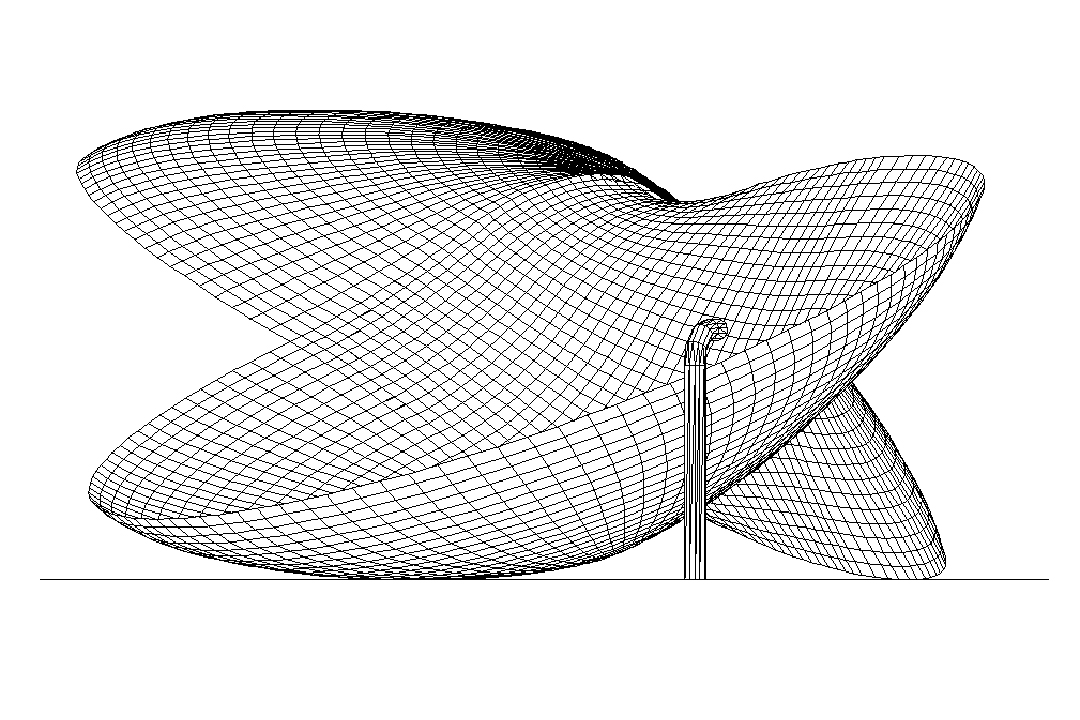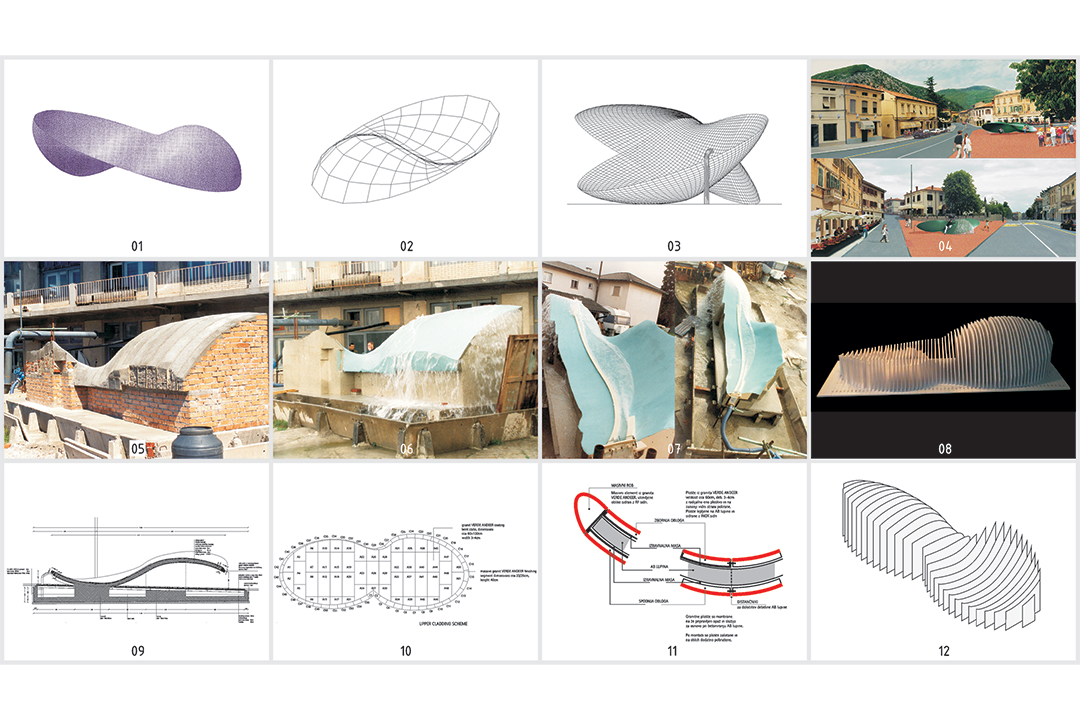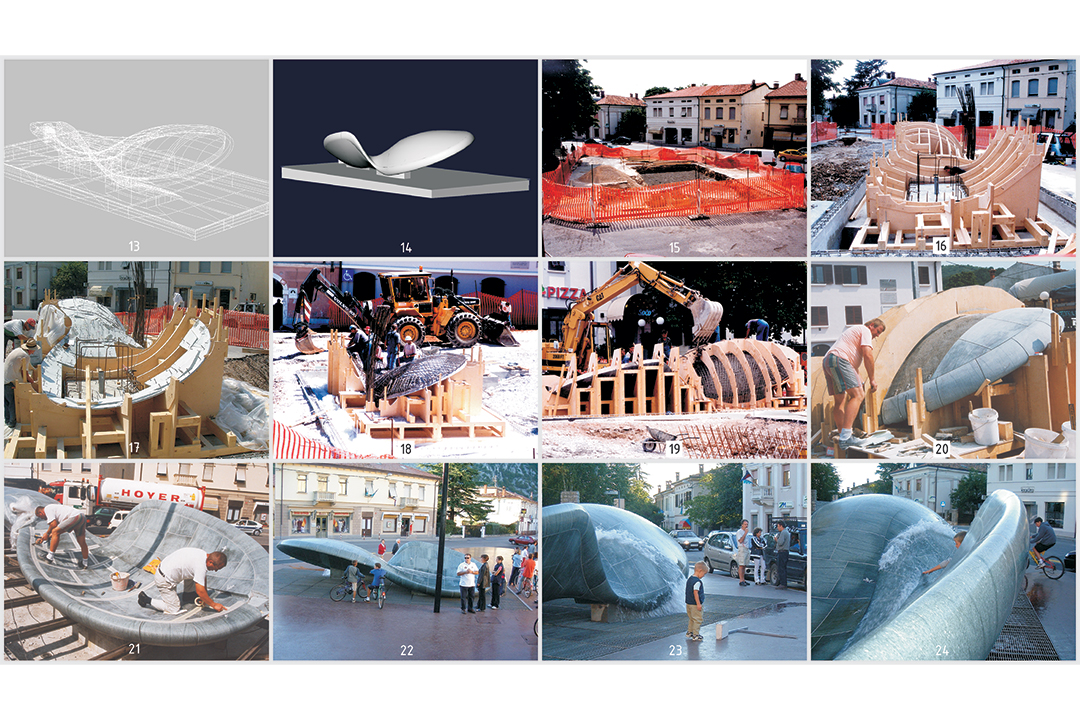The fountain is placed in the geometrical centre of J. Srebreniče Square in Solkan. Its 620 square feet of floor area is covered in red asphalt and is in the shape of a triangle with one peak pointing to the north. The fountain itself is a 4x9 m convex-concave shell, 1.8 m high, and its longer side extends in a NE-SW direction. Water gushes from a nozzle along the concave receptacle and then up the saddle, only to lose impetus at its peak and flow all over the convex surface. The fountain is placed above a 5.8 x11.3 m pool which collects the water and is covered by a metal grating. The foundation slab is 25 cm thick. The fountain is formed by two mutually inversed elliptic paraboloids overlapping in the saddle. The fountain is poured in MB 30 concrete, and with the biggest aggregate fractions of 8 mm. The reinforced concrete shell is 12 cm thick, with 30 cm butts at the points of support. On both sides, the fountain is sheathed in 3-4 cm thick, 120x60 cm double-warped granite slabs. The water-directing channels are in stone and make up part of the sheathing. Massive granite segments, 22/25 cm wide and 40 cm long, form the rim. The granite sheathing and massive rims are made of green Verde Andeer. (Excerpt from the technical report)
Let’s enter the world of Sadar Vuga Arhitekti (SVA) and learn about the fountain through that world. To do that, we need to take a small yet important step; a mental leap so to speak, a memory reset. Our memories, thoughts, and architectural discourse can all get in the way of our understanding and experience. The next step will be to demystify the creative process by demystifying the phenomenon of SVA:
What is functional architecture? What is pragmatic architecture? Is there perverse architecture? Is the fountain formalist? Is it contextual? Is it ethical? Does interpreting architecture or the above categories make any sense at all?
Unlike classical architecture discourses, the fountain in Solkan does not belong to any particular architectural language. It represents an architectural effect in the purest sense of the words. Here, we come to the essence of SVA’s creative process. According to Marshall McLuhan, individual perception is determined more by the nature of the medium than by its content. Simply put, the effect media produce on an individual take the upper hand over the content they carry. If this statement is true, it sheds a completely different light on architecture. Architecture cannot be encompassed by terms such as content and form, or syntax and semantics. The current theory of architecture describes two major approaches to creation. The first refers to “design” (the formal approach) and the second to “diagram” (the programmatic approach). SVA proposes a third approach, referred to as an architectural effect, which does not exclude the other two approaches.

What is (if anything) generative in the world of SVA? Generative is the process of creation. Non-generative is an architectural effect which is specific and unique to every single product. In the world of SVA, there is always the risk of new architectural effects.
Here we can talk about the hyperboloidical world of SVA. Unlike the cause-and-effect world, the hyperboloidical world is non-linear (non-Cartesian) and indefinite. The domain of creation and architectural discourse, with a great time shift (as opposed to other sciences), seems to shift from the absolute perspective towards the relative, that is, from the object towards the subject.
The term hyperboloidical encompasses all levels of the SVA world: the working technique, the physical object, and perception. As will clearly be shown, the technique used for the design of the fountain is characterised by iteration, that is, an algorithm which produces a series of approximations through iteration. The longer the process, the closer we get to an ideal solution, which is mathematically impossible. The iteration occurs through the interaction between the computer and the physical model.
The design procedure technique of the fountain in Solkan starts with the choice of prototype (Figure 1). The sketch design, at the same time a competition scheme, was made by prototype application (Figures 2, 3 and 4). The part of the fountain where water will pass through is divided into 27 sections (Figure 5) which serve to test the behaviour of water on a physical full-scale model (Figure 6). To adjust the jet of water, corrections are made to the shape of the physical model (Figure 7) and to the nozzle. Then comes the construction of the model of shuttering at a scale of 1:100 (Figure 8). After the hydro-mechanical testing of the physical model, corrections follow in the computer model and the building permit design is then submitted (Figure 9). The stone grid is determined in cooperation with the stone layer contractor (Figure 10). Work progress is determined by the construction details (Figure 11). A computer model of shuttering (Figure 12) is made to facilitate the laying of the lower stone sheathing. The final 3D model is completed in the computer-modelling studio (Figures 13 and 14). The wooden shuttering consisting of transversal wooden ribs (Figure 16) as a base for the stone lower sheathing is placed on the slab (Figure 17). On the reinforcement wire mesh (Figure 18), the shuttering for the upper stone sheathing is placed (Figure 19) and then the reinforced concrete shell is poured. Next the upper sheathing and the massive rims are laid (Figure 20). The stonework is completed by pointing (Figure 21). The square comes back to life after the opening (Figures 22, 23, and 24).


We can also talk about the hyperboloidness of the physical object itself. The fountain’s geometry can by no means be described by simple linear equations. At best, equations of the second order are needed. These are further modified by optimising the flow of water.
Why is the perception of the fountain also hyperboloidical? On analogy with the method of a finite number of elements (construction physics) which serves to approximate the tension in a certain point on the fountain, it is not possible to determine the size, the form or the material quality of the fountain with reasonable accuracy from the observer’s point of view.
The SVA fountain is defined as the landscaper, that is, an independent object epitomising the surrounding landscape. The landscaper simulates activities occurring in the landscape, the constituent of which is water. Water, and hence the fountain, is omnipresent. Even if we close our eyes, we can still hear it.
Before we close:
Forget everything we said about the fountain. Empty your ROM; reboot the operational system, for there is no architecture criticism. What there is, is my (your) experience. To conclude: what do I think of the fountain? I simply like it. I suggest you experience it that way too.
An old Zen master is on his deathbed. Come the last day of his life, he announces that he will die that evening. His disciples and friends come to pay their respects. The master’s last wish is that he be brought his favourite cake. He takes it in his dying, yet firm, hand. Then he takes a bite and starts to enjoy it audibly. Someone ventures to ask: “Master, what are your last words of wisdom?” The master laughs and replies: “This cake is really good.”